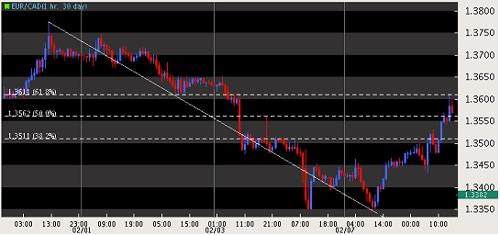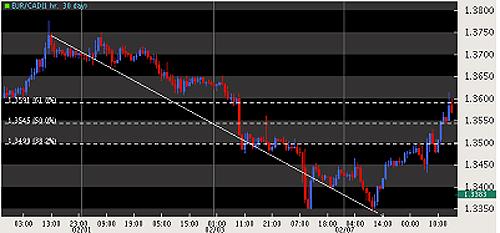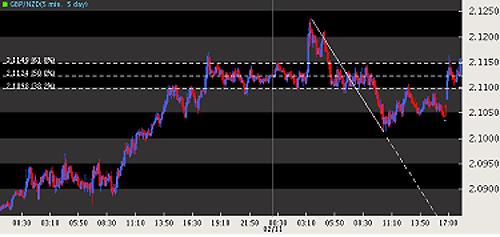Improperly applying technical analysis methods will lead to disastrous results, such as bad entry points and mounting losses on currency positions. Here we'll examine how not to apply Fibonacci retracements to the foreign exchange markets. Get to know these common mistakes and chances are you'll be able to avoid making them and suffering the consequences in your trading.
Don't Mix Reference Points
When fitting Fibonacci retracements to price action, it's always good to keep your reference points consistent. So, if you are referencing the lowest price of a trend through the close of a session or the body of the candle, the best high price should be available within the body of a candle at the top of a trend: candle body to candle body; wick to wick.
Incorrect analysis and mistakes are created once the reference points are mixed—going from a candle wick to the body of a candle. Let's take a look at an example in the EUR/CAD currency pair. Figure 1 shows consistency. Fibonacci retracements are applied on a wick-to-wick basis, from a high of 1.3777 to a low of 1.3344. This creates a clear-cut resistance level at 1.3511, which is tested, then broken.

Fig1 - Fibonacci retracement applied to Price Action for EUR/CAD
Source: FXtrek.com
Fig 2, on the other hand, shows inconsistency. Fibonacci retracements are applied from the high close of 1.3742 (35 pips below the wick high). This causes the resistance level to cut through several candles (between February 3 and February 7), which is not a great reference level.

Fig 2 - Fibonacci Retracement (Incorrectly applied)
Source: FXtrek.com
By keeping it consistent, support and resistance levels will become more apparent to the naked eye, speeding up analysis and leading to quicker trades.
Don't Ignore Long-Term Trends
New traders often try to measure significant moves and pullbacks in the short term without keeping the bigger picture in mind. This narrow perspective makes short-term trades more than a bit misguided. By keeping tabs on the long-term trend, the trader can apply Fibonacci retracements in the correct direction of the momentum and set themselves up for great opportunities.
In Fig 3, below, we establish the long-term trend in the GBP/NZD currency pair is upward. We apply Fibonacci and see our first level of support is at 2.1015, or the 38.2% Fibonacci level from 2.0648 to 2.1235. This is a perfect spot to go long in the currency pair.

Fig 3 - Fibonacci retracement applied to GBP/NZD establishes a long term move.
Source: FXtrek.com
But, if we take a look at the short term, the picture looks much different.

Fig 4 - Fibonacci retracement applied on a short time-frame can give the trader a false impression.
Source: FXtrek.com
After a run-up in the currency pair, we can see a potential short opportunity in the five-minute time-frame (Fig 4). This is the trap. By not keeping to the longer-term view, the short seller applies Fibonacci from the 2.1215 spike high to the 2.1024 spike low (February 11), leading to a short position at 2.1097, or the 38% Fibonacci level.
This short trade does net the trader a handsome 50-pip profit, but it comes at the expense of the following 400-pip advance. The better plan would have been to enter a long position in the GBP/NZD pair at the short-term support of 2.1050.
Keeping in mind the bigger picture will not only help you pick your trade opportunities, but will also prevent the trade from fighting the trend.
Don't Rely on Fibonacci Alone
Fibonacci can provide reliable trade setups, but not without confirmation.
Applying additional technical tools like MACD or stochastic oscillators will support the trade opportunity and increase the likelihood of a good trade. Without these methods to act as confirmation, a trader has little more than hope for a positive outcome.
In Fig 5, we see a retracement off a medium-term move higher in the EUR/JPY currency pair. Beginning on January 10, 2011, the EUR/JPY exchange rate rose to a high of 113.94 over almost two weeks. Applying our Fibonacci retracement sequence, we arrive at a 38.2% retracement level of 111.42 (from the 113.94 top). Following the retracement lower, we notice the stochastic oscillator is also confirming the momentum lower.

Fig 5 - The stochastic oscillator confirms a trend in the EUR/JPY
Source: FXtrek.com
Now the opportunity comes alive as the price action tests our Fibonacci retracement level at 111.40 on January 30. Seeing this as an opportunity to go long, we confirm the price point with stochastic, which shows an oversold signal. A trader taking this position would have profited by almost 1.4%, or 160 pips, as the price bounced off the 111.40 and traded as high as 113 over the next couple of days.
Using Fibonacci for Short-Term
Day trading in the foreign exchange market is exciting, but there is a lot of volatility.
For this reason, applying Fibonacci retracements over a short time-frame is ineffective. The shorter the time-frame, the less reliable the retracement levels. Volatility can, and will, skew support and resistance levels, making it very difficult for the trader to really pick and choose what levels can be traded. Not to mention in the short term, spikes and whipsaws are very common. These dynamics can make it especially difficult to place stops or take profit points as retracements can create narrow and tight confluences. Just check out the CAD/JPY example below.

Fig 6 - Fibonacci applied to an intra-day move on CAD/JPY over a three-minute time frame.
Source: FXtrek.com
In Fig 6, we attempt to apply Fibonacci to an intra-day move in the CAD/JPY exchange rate chart (over a three-minute time-frame). Here, volatility is high. This causes longer wicks in the price action, creating the potential for mis-analysis of certain support levels. It also doesn't help that our Fibonacci levels are separated by a mere six pips on average, increasing the likelihood of being stopped out.
Remember, as with any other statistical study, the more data used, the stronger the analysis. Sticking to longer time-frames when applying Fibonacci sequences can improve the reliability of each price level.
In Summary
As with any speciality, it takes time and practice to become better at using Fibonacci retracements in forex trading. Don't allow yourself to become frustrated—the long-term rewards definitely outweigh the costs. Follow the simple rules of applying Fibonacci retracements and learn from these common mistakes to help you analyze profitable opportunities in the currency markets.
Richard Lee can be contacted on this link: Richard Lee
Last edited by a moderator:

![[IMG] [IMG]](/proxy.php?image=https%3A%2F%2Fi.ibb.co%2F52HJ23t%2Faudusd23022021.png&hash=670ce00313029884d113f456e8429359)
![[IMG] [IMG]](/proxy.php?image=https%3A%2F%2Fi.ibb.co%2FjTtzMGc%2Fusdjpy23022021.png&hash=d5b2c4c0033e501f74c824c65cac4c4f)
![[IMG] [IMG]](/proxy.php?image=https%3A%2F%2Fi.ibb.co%2FRB6vp3z%2Fusdcad23022021.png&hash=795761b5942385db6c08e31c9621a15e)
![[IMG] [IMG]](/proxy.php?image=https%3A%2F%2Fi.ibb.co%2Fqn3GJJ2%2Fusdchf23022021.png&hash=4eb3a7a5bf8073b774d4e6a089ae8dbc)